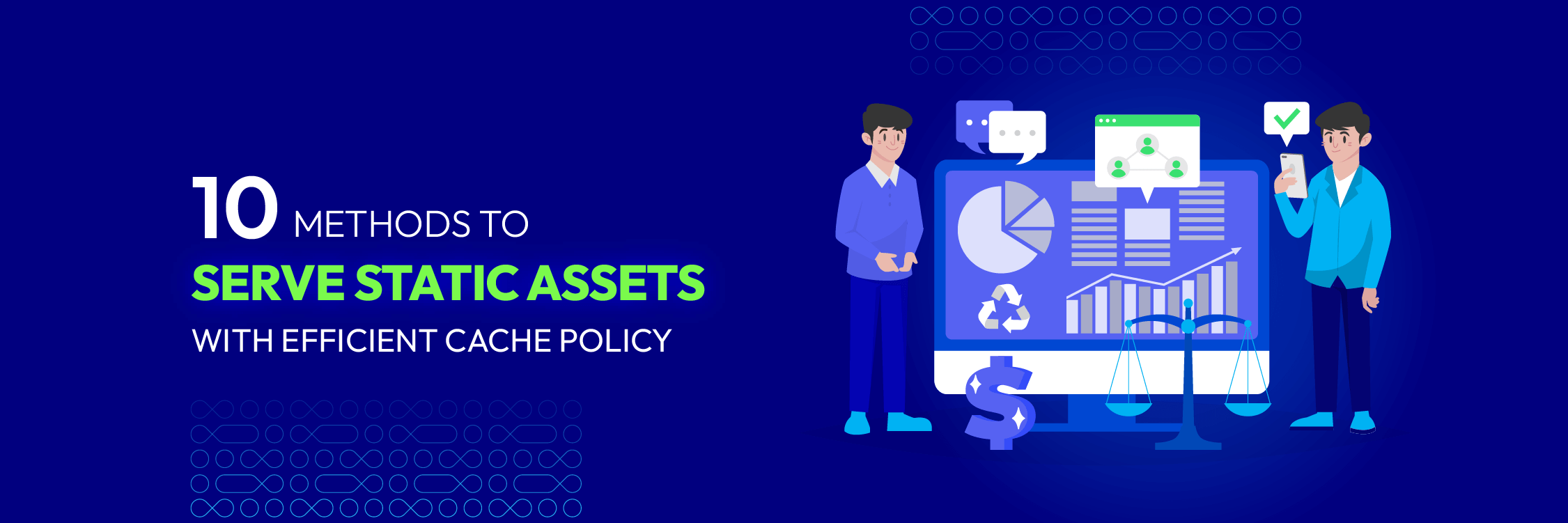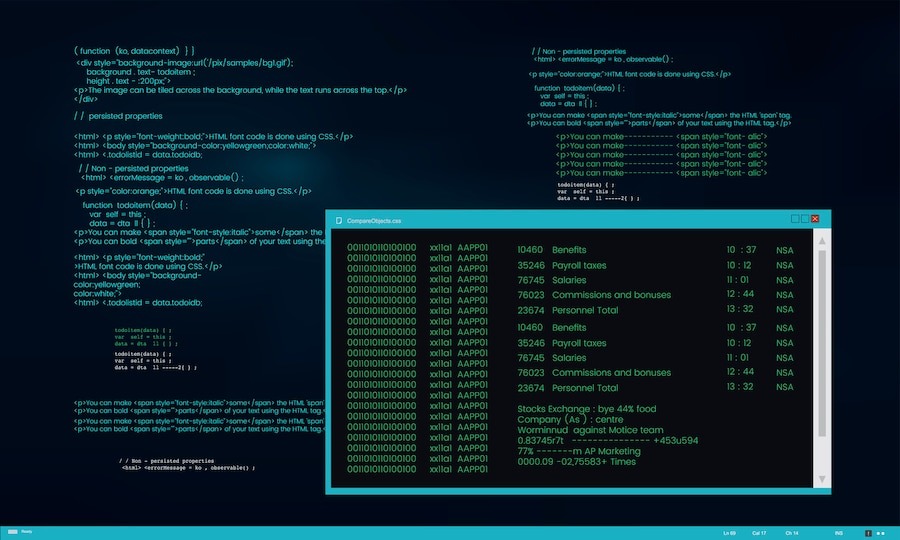10 Methods to Serve Static Assets With an Efficient Cache Policy
Vinh Jacker | 10-13-2023

Did you know that the average web page size in 2023 is 4.5 MB and that 75% of it consists of static assets?
A whopping 75% of that data is composed of static assets! These static assets, files that don’t change like images, CSS, and JavaScript, are fundamental to web optimization. How we manage them can significantly impact your website’s performance – and, ultimately, your user experience.
Serve static assets with an efficient cache policy is not a luxury; it’s a necessity. An efficient cache policy can substantially impact your website’s performance, transforming user experiences and potentially leading to higher conversion rates.
This blog post will discuss and explore serve static assets with an efficient cache policy, demystifying cache policies, and share some of the most effective methods for serving static assets with an efficient cache policy. We’ll also dive into real-world examples and discuss potential pitfalls you might encounter in the process.
Whether an experienced web developer or a novice, you’ll find practical insights and strategies to elevate your static asset management game.
Understanding the importance of serving static assets
Serving static assets refers to the process of sending files from a server to a client’s browser. Static assets are files that don’t need to be modified or processed by the server before being sent to the client. They include files such as HTML, CSS, JavaScript, images, and videos. These files are often cached by the browser to improve load times and reduce the amount of data that needs to be transferred for future requests.

Just as a timepiece relies on these parts to function efficiently, so does a webpage rely on static assets. Unlike dynamic content, these elements remain unchanged unless manually updated, allowing us to store or ‘cache’ them at various points between the server and the user. The result? Reduced data transfers and dramatically increased loading speed.
Why is speed so critical? Users expect immediate responses. Every millisecond saved in loading your website can contribute to a significantly better user experience.
Let’s break down the benefits of serving static assets with an efficient cache policy:
- Improved user experience: A fast-loading website can keep users engaged, reducing bounce rates and potentially increasing conversion rates.
- Server efficiency: By serving static assets efficiently, we reduce the pressure on the server, freeing up valuable resources to handle dynamic content and enhancing the website’s overall performance.
- Environmental impact: The less data we need to transfer, the less energy we consume. In an era of increasing environmental consciousness, serving static assets efficiently can help reduce a website’s carbon footprint.
- SEO ranking: Page load speed is a factor that search engines consider when ranking websites. By efficiently serving static assets with an efficient cache policy and speeding up your site, you improve its potential to rank higher in search results. This could bolster your site’s organic traffic, enhancing user interaction and boosting conversion rates.
- Scalability: An efficient static asset delivery system helps improve scalability. As your website expands and draws in more traffic, employing efficient methods for serving static assets – like browser caching or a CDN – can keep your server from overloading. This means your site remains stable and performs well, even as your user base expands.
With this understanding of static assets’ crucial role, we are well-equipped to delve deeper into our next topic: the intricacies of cache policies.
Explanation of cache policy
To fully grasp the concept of serving static assets with an efficient cache policy, we should first understand its foundation. ‘Cache’ refers to a fast-paced data storage layer that retains a subset of data, typically temporary. When the same data is requested, having it stored in a cache means it can be served up significantly faster than if it had to be accessed from the data’s primary storage location.
When a user visits a website for the first time, their browser downloads all the static assets – images, CSS files, JavaScript files, and more – that are required to display the site correctly. When these static assets are cached, they don’t need to be re-downloaded every time the user revisits the site. Instead, the browser loads them from the cache, accelerating the load time considerably and ensuring a smooth and efficient user experience.

But how does the browser know when to load from the cache and when to download afresh from the server? This question brings us to the core of our topic: serve static assets with an efficient cache policy.
A cache policy, also known as HTTP cache headers, provides instructions to the browser about how to use locally cached responses for subsequent requests to the same resource. These policies are rules that determine how, when, and for how long a browser should cache and re-use specific responses.
There are several types of cache policies that developers can set, each offering different degrees of cacheability:
- Public: This policy indicates that the response may be cached by any cache, including those shared by multiple users.
- Private: This policy is quite the opposite of ‘public.’ This indicates that the response is designed for a singular user, and a shared cache should not retain it. This is often used for user-specific, sensitive information.
- No-cache: This directive allows caching but requires the browser to revalidate with the server before using the cached response for subsequent requests. This ensures that the user always receives the most updated content.
- No-store: This directive is the strictest and prevents the browser and all intermediate caches from storing any version of the returned response. It is used when the information is sensitive, and no caching should be allowed.
Understanding and setting up the appropriate cache policies for your static assets is crucial to optimizing your site’s load times and ensuring that your users always get the most relevant and updated content.
10 Methods to serve static assets with an efficient cache policy
1. Browser caching and Cache-Control
Implementing browser caching is a widely-used method to serve static assets with an efficient cache policy. It stores static assets like CSS, JavaScript files, and images in the local browser cache, thus speeding up the loading time of websites during subsequent visits.
2. Content Delivery Network (CDN) and cache policy
Using a Content Delivery Network (CDN) is another way to serve static assets with an efficient cache policy. The delivery of web content to users is facilitated by a worldwide network of servers that takes into account their location, resulting in reduced latency.
3. ETag (Entity Tag) and cache matching
The ETag (Entity Tag) is an HTTP response header used to serve static assets with an efficient cache policy. It determines whether the version of the resource stored in the cache corresponds to the current version on the server.
4. Last-Modified header and cache freshness
The Last-Modified header, another HTTP response header, is crucial to serving static assets with an efficient cache policy. It provides the date and time when the server believes the resource was last modified.
5. Expires header and cache expiration
The Expires header is an HTTP response header that informs the browser when to use the cached copy of the resource. It’s essential for serving static assets with an efficient cache policy as it indicates when the cached resource becomes stale and needs to be re-fetched from the server.
6. Webpack for bundling and minification
Webpack is a static module bundler for JavaScript-based applications, and it’s key to serving static assets with an efficient cache policy. It allows developers to bundle and minify their code, reducing the file size of static assets.
7. Gzip compression
Gzip is a method used for compressing files, making it integral to serving static assets with an efficient cache policy. It accelerates network transfers by reducing the size of data that needs to be transferred.
8. Image optimization
Image optimization is an important part of serving static assets with an efficient cache policy. It significantly reduces the size of static assets as images often comprise the bulk of web page data.
9. HTTP/2 server push
HTTP/2 Server Push, which allows the server to deliver multiple responses for a single client request, is vital for serving static assets with an efficient cache policy. It reduces the number of round trips needed to fetch all assets by sending them as soon as the HTML document is requested.
10. Service workers for caching
Service workers are web workers that operate in the background. They’re crucial to serve static assets with an efficient cache policy as they can intercept and modify navigation and resource requests, and cache resources.
Service workers can significantly improve loading speed by pre-caching essential resources and serving them from the cache, particularly for repeat visits. They also allow for more complex caching strategies to improve performance even further.
Site Audit Services
Mageplaza offers FREE site health check (15hrs) to help you identify any website flaws & weaknesses and fix them before they start costing you a fortune.
Explore More
Case studies and examples
Case Study 1: Google’s use of browser caching
Google, one of the world’s most visited websites, understands the importance of load time on user experience and search ranking. To serve static assets with an efficient cache policy, they have implemented browser caching, which stores frequently used static assets on users’ local hard drives.
This method reduces server lag, enabling web pages to load faster during subsequent visits. According to Google’s data, a delay of over two seconds in load time can increase bounce rates by more than 103%. Hence, their use of browser caching to serve static assets with an efficient cache policy significantly improves user experience and engagement.
Case Study 2: Netflix’s implementation of CDN
Netflix, the world’s leading streaming platform, uses Content Delivery Networks (CDNs) to serve static assets with an efficient cache policy, delivering content quickly and efficiently to users worldwide. They have even created their own CDN, Open Connect, which stores and delivers most of their static content, including movie and show files.

By serving static content to each user from the nearest physical location, Netflix ensures high-quality streaming with minimal buffering. This approach of serving static assets with an efficient cache policy has been instrumental in their success, allowing them to accumulate more than 200 million subscribers across the globe.
Case Study 3: Etsy and image optimization
Etsy, a worldwide marketplace renowned for its unique and creative goods, is home to millions of product images. Thus, image optimization to serve static assets with an efficient cache policy is a critical factor in the site’s performance. They implemented a dynamic image resizing service, automatically adjusting image size based on the user’s device and viewport.
Furthermore, they employ suitable formats for various image types and compress images to reduce their file sizes without causing a noticeable reduction in quality. As a result, they have achieved faster page loads and a more responsive site, which significantly enhances the shopping experience and leads to higher conversion rates.
Potential pitfalls and challenges
-
- Inefficient cache policies: While caching can significantly improve loading speeds, an inefficient cache policy can cause issues. Users may not receive updates promptly if the cache duration is set too long. Conversely, a too-short cache duration might negate the benefits of caching.
- Overdependence on CDNs: CDNs significantly speed up the delivery of static assets, but over-dependence can pose a risk. If the CDN experiences an outage, it can impact your site’s performance. Always having a fallback mechanism in place is good practice.
- Improper implementation of HTTP/2 server push: HTTP/2 Server Push can speed up initial page loads, but improper implementation can lead to inefficiencies. It could send resources to the client the browser has already cached, wasting bandwidth.
- The complexity of service workers: Service workers can powerfully control caching but also introduce complexity. Debugging service worker code can be tricky due to its life cycle and running separately from the main browser thread.
- Resource prioritization: In the quest for speed, it’s crucial not to lose sight of resource prioritization. Not all resources are created equal – some are more critical to the user experience than others. Strategies like lazy loading can help ensure that the most critical resources are loaded first, ensuring a smoother user experience.
Conclusion
It is imperative to serve static assets utilizing an effective cache policy. As our examination of various methods and real-world case studies has shown, correctly implementing such strategies can dramatically improve website performance, user experience, and overall engagement. However, it is also essential to remain mindful of potential pitfalls and challenges, ensuring that your approach is practical and resilient.
From leveraging browser caching and CDNs to utilizing modern technologies such as HTTP/2 and service workers, there are numerous ways to optimize the delivery of static assets. Remember that there is no one-size-fits-all solution. The right mix of methods will depend on your website or application’s specific needs and constraints.
Keeping up with the latest best practices for serving static assets is crucial for successful web development in the evolving digital world. Though it’s an ongoing process, its benefits in improved performance, user satisfaction, and the overall success of your online presence are significant.






![Top 20+ Must-have Shopify Apps for 2025 [Free & Paid] - Mageplaza](https://cdn2.mageplaza.com/media/blog/must-have-shopify-apps/top-must-have-shopify-apps.png)
![[2025 Updates] Top 10+ Upsell Apps for Shopify - Mageplaza](https://cdn2.mageplaza.com/media/blog/best-upsell-shopify-app/cover.png)